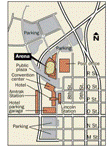Community and Regional Planning Program

Community and Regional Planning Program: Faculty Scholarly and Creative Activity
Document Type
Article
Date of this Version
10-2012
Citation
Wetlands: Official Scholarly Journal of the Society of Wetland Scientists, vol. 32, iss. 5 (October 2012), pp. 975–984; doi: 10.1007/s13157-012-0320-x; erratum doi: 10.1007/s13157-012-0329-1
Abstract
It is always challenging for decision makers to prioritize wetland conservation programs at the landscape scale. This study employed a GIS-based multi-criteria spatial decision support tool that identified locations with the highest restoration potential for wetland conservation programs in the Rainwater Basin in south-central Nebraska. Five indicators were considered to assess wetland restoration potential: (1) Vegetation characteristics; (2) Soil characteristics; (3) Water volume released from hydrological modification of agricultural irrigation pits; (4) Topographical depression status; and (5) Habitat condition. The results suggested 192 (1.6% of the total) hydric soil footprints as the highest prioritized locations for future wetland restoration programs. The results also identified 901 footprints (7.7% of the total) with medium-high restoration potential, 1,792 (15.2% of the total) footprints with medium-low restorable potential and 8,875 (75.5% of the total) footprints with low restorable potential. The methodology and statistical results contribute directly to the state’s Rainwater Basin Wetland Program Plan and are potentially applicable to the management of other wetlands across the region and globally.
Included in
Biodiversity Commons, Bioresource and Agricultural Engineering Commons, Terrestrial and Aquatic Ecology Commons, Urban, Community and Regional Planning Commons


Comments
Copyright © 2012 Society of Wetland Scientists; published by Springer Verlag. Used by permission.